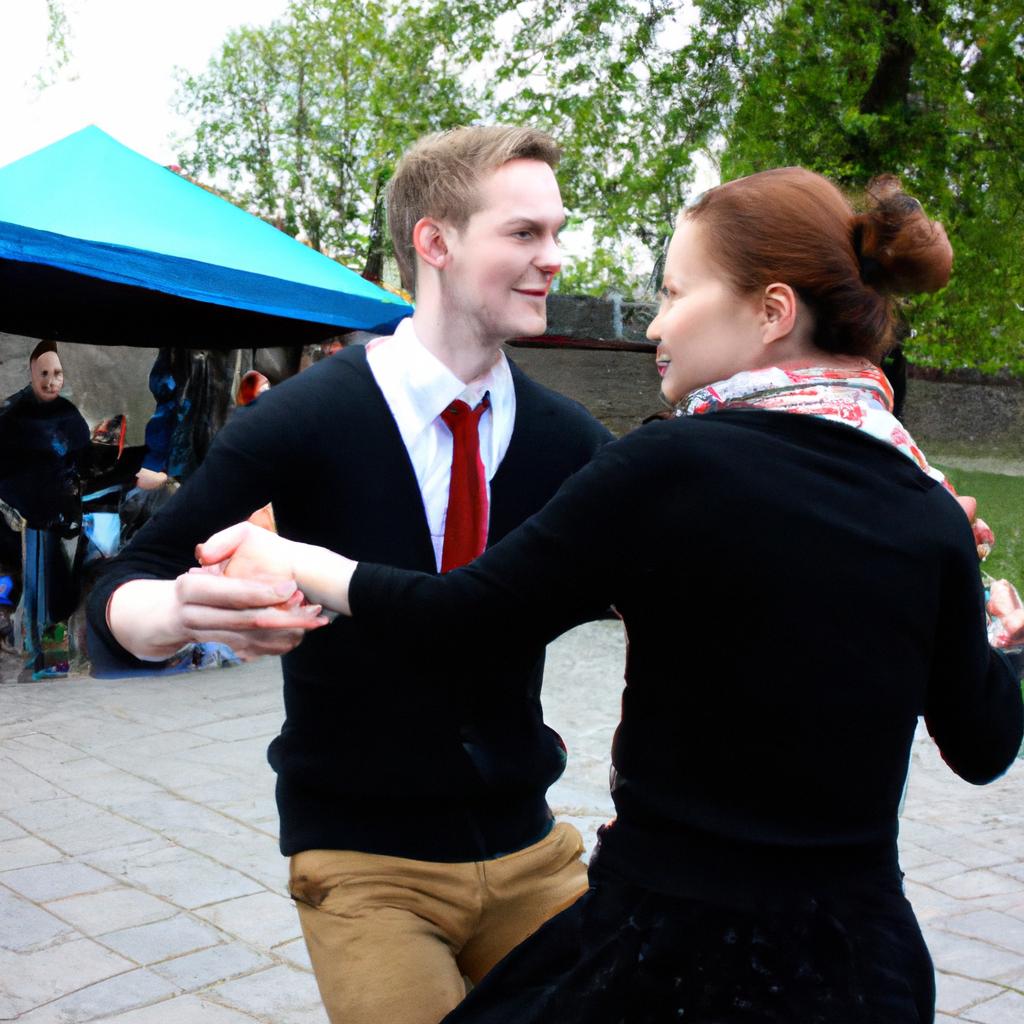Latin dance has gained popularity as a form of recreation and sports dancing in recent years. This energetic and passionate style of dance encompasses various genres such as salsa, bachata, merengue, and cha-cha-cha. With its rhythmic movements and vibrant music, Latin dance offers individuals an opportunity to express themselves artistically while also engaging in physical activity.
One example that highlights the appeal of Latin dance is the case study of Maria, a middle-aged woman who found herself seeking a new hobby after retiring from her corporate job. Feeling disconnected from her body and longing for a way to stay active, she stumbled upon a local Latin dance studio offering beginners’ classes. Intrigued by the exotic rhythms and sensual movements, Maria decided to give it a try. Little did she know that this decision would not only provide her with a recreational outlet but also transform into a lifelong passion.
As more people like Maria discover the joy of Latin dance, understanding its roots, techniques, and benefits becomes essential. In this article, we will explore the world of Latin dance: delving into its history, examining different styles within the genre, discussing basic steps and techniques, uncovering the mental and physical health advantages associated with it, and even exploring opportunities for competitive performance and social dancing.
Latin dance has a rich history that can be traced back to various regions in Latin America and the Caribbean. It is influenced by African, European, and Indigenous cultures, resulting in a diverse range of styles and rhythms. For example, salsa originated in Cuba and Puerto Rico, while bachata originated in the Dominican Republic. Each style carries its own unique characteristics, but they all share a common thread of passion and expression.
In terms of basic steps and techniques, Latin dance typically involves fast footwork, hip movements, and intricate partner work. Salsa, for instance, incorporates patterns such as cross body leads, turns, and shines (individual footwork). Bachata emphasizes sensual body isolations and close connection with your partner. Learning these steps may seem daunting at first, but with practice and guidance from experienced instructors, anyone can become proficient.
The benefits of Latin dance extend beyond just physical exercise. Engaging in this art form can improve cardiovascular health, increase flexibility and coordination, boost self-confidence, reduce stress levels, enhance social connections through partner dancing or group classes. Moreover dancing releases endorphins which can elevate mood.
For those looking to take their passion for Latin dance to the next level or showcase their skills on a competitive stage or social dance floor there are numerous opportunities available. Many cities have vibrant Latin dance communities with regular social events where dancers gather to enjoy music and dance together. Additionally,
there are also national and international competitions where dancers compete against each other based on technique
and performance ability.
Whether you’re seeking a new hobby or looking to challenge yourself physically and creatively,
Latin dance offers an exciting avenue for self-expression,
connection,
and personal growth.
Latin Dance: History and Origins
Imagine a bustling dance hall in the vibrant streets of Havana, Cuba. The room is filled with couples gracefully moving to the pulsating rhythms of Afro-Cuban music. This scene captures the essence of Latin dance, an art form that has captivated people around the world for centuries.
The origins of Latin dance can be traced back to various regions in Latin America and the Caribbean. Its roots lie in the fusion of African and European cultures during colonization. As enslaved Africans were brought to these lands, their rich cultural traditions merged with those of indigenous populations and European settlers. From this blend emerged a distinctive style characterized by infectious energy, sensual movements, and intricate footwork.
To appreciate the depth and diversity of Latin dance, it is essential to understand its historical context. Here are some key points:
- Cultural Fusion: Latin dance reflects the syncretism between African, Indigenous, and European traditions.
- Ritualistic Origins: Many dances originated as spiritual or ceremonial rituals before transitioning into recreational forms.
- Social Significance: Throughout history, Latin dance has played a significant role in social events such as weddings, festivals, and community celebrations.
- Global Influence: Over time, Latin dance spread beyond its place of origin and became popular worldwide due to globalization and media exposure.
To further illustrate the impact of Latin dance on individuals and communities alike, consider the following emotions often associated with this art form:
| Emotion | Description |
|---|---|
| Passion | The intense fervor expressed through every move |
| Connection | The profound bond created between partners |
| Joy | The sheer happiness experienced while dancing |
| Liberation | The feeling of freedom from societal constraints |
With its ability to evoke such powerful feelings within participants and spectators alike, it comes as no surprise that Latin dance continues to thrive today across different cultures and generations. This enduring art form has transcended time, reflecting the resilience of its originators and the universal appeal of movement as a means of communication.
Transitioning seamlessly into our next section, we will delve deeper into the various types of Latin dances, exploring their unique characteristics and cultural significance.
Types of Latin Dances
Latin dance has a rich history that dates back several centuries. It originated in Latin America, where it was deeply intertwined with the culture and traditions of various countries in the region. One such example is the famous salsa dance, which emerged in the 1970s in New York City as a fusion of Cuban son, Puerto Rican bomba, and other Afro-Caribbean dances. This captivating dance form quickly gained popularity worldwide due to its energetic movements and vibrant music.
Now, let us explore the different types of Latin dances that have captivated dancers and audiences alike:
-
Salsa: Known for its infectious rhythm and quick footwork, salsa is one of the most popular Latin dances around the world. Originating from Cuba and Puerto Rico, this lively partner dance incorporates elements of mambo, cha-cha-cha, and other Caribbean rhythms.
-
Bachata: Hailing from the Dominican Republic, bachata is characterized by sensual hip movements and close embrace between partners. With its romantic melodies and heartfelt lyrics, this dance style evokes strong emotions among both dancers and spectators.
-
Merengue: The national dance of the Dominican Republic, merengue is a fast-paced social dance that involves simple steps combined with hip sways. Its upbeat tempo makes it an excellent choice for beginners looking to get their feet moving on the dance floor.
-
Cha-Cha-Cha: Originally from Cuba, cha-cha-cha became popularized internationally during the 1950s. This dance style features syncopated steps mixed with playful hip action, creating a dynamic yet elegant performance.
The emotional allure of Latin dancing can be further understood through these bullet points:
- Euphoric feelings arise when synchronizing intricate footwork with pulsating beats.
- Intense connections are formed between partners through non-verbal communication.
- Confidence soars as dancers master complex moves while expressing their individuality.
- Joy and excitement fill the air as dancers let loose, immersing themselves in the rhythm of Latin music.
Additionally, a table can visually demonstrate the diversity within Latin dance:
| Dance Style | Country of Origin | Key Characteristics |
|---|---|---|
| Salsa | Cuba | Energetic footwork |
| Bachata | Dominican Republic | Sensual hip movements |
| Merengue | Dominican Republic | Fast-paced social dance |
| Cha-Cha-Cha | Cuba | Syncopated steps |
With its vibrant history and diverse array of dance styles, Latin dancing has something to offer for everyone. In the subsequent section on “Benefits of Latin Dance,” we will explore how engaging in this expressive art form can positively impact physical health and emotional well-being.
Benefits of Latin Dance
Imagine a scenario where Maria, a young woman from a small town in Mexico, discovers her passion for Latin dance. After attending her first salsa class, she becomes captivated by the vibrant rhythms and expressive movements that embody this form of recreation and sport dancing. This case study highlights the transformative power of Latin dance as we delve into its rich history and cultural significance.
Latin dance encompasses various styles originating from different countries in Latin America. These dances serve as an outlet for self-expression, allowing individuals to connect with their heritage while embracing the joy of movement. From the sensuality of the Argentine tango to the energetic beats of merengue, each style offers a unique experience for both dancers and spectators alike.
The benefits of engaging in Latin dance extend beyond physical fitness; they also foster social connections and promote cultural understanding. Let us explore some key reasons why people are drawn to this captivating art form:
- Encourages self-confidence: As dancers master complex steps and execute them flawlessly on the dance floor, they gain confidence in their abilities, leading to enhanced self-esteem.
- Facilitates personal growth: Through continuous practice and dedication, individuals can develop discipline, perseverance, and resilience – qualities that transcend into other areas of life.
- Promotes emotional well-being: Moving rhythmically to infectious music provides an avenue for stress relief and emotional release.
- Fosters community engagement: Participation in group classes or social events encourages interaction among fellow enthusiasts which helps build supportive friendships within the dance community.
| Dance Style | Country of Origin | Distinguishing Characteristics |
|---|---|---|
| Salsa | Cuba | Quick footwork combined with sensual hip movements |
| Bachata | Dominican Republic | Romantic and intimate dance with smooth hip sways |
| Cha-Cha-Cha | Cuba | Energetic dance style featuring syncopated steps |
| Samba | Brazil | Lively, carnival-inspired movements |
As we delve into the subsequent section on basic steps and techniques, it becomes clear that Latin dance is more than just a physical activity; it represents a rich tapestry of cultural heritage. By understanding its historical roots and significance, dancers can fully appreciate the art form as they embark on their journey to mastery.
Next Section: Basic Steps and Techniques
Basic Steps and Techniques
Latin Dance: A Guide to Recreation and Sports Dancing
Having explored the various benefits of engaging in Latin dance, it is now essential to understand the basic steps and techniques that form its foundation. By mastering these fundamental elements, dancers can enhance their skills and fully immerse themselves in the captivating world of Latin dance.
Basic Steps and Techniques:
To truly grasp the essence of Latin dance, one must first become acquainted with a few key steps and techniques. Let us consider the example of the salsa dance style. Salsa involves intricate footwork, partnering, body movement, and stylized improvisation. As an illustration, imagine a couple gracefully moving across the dance floor, seamlessly transitioning between spins, turns, and quick foot shuffles while maintaining synchronization with each other’s movements.
When learning Latin dance styles such as salsa or bachata, practitioners often focus on developing specific techniques to ensure fluidity and precision in their movements. Below are some vital aspects to master:
- Footwork: Proper footwork forms the basis for any Latin dance style. It involves stepping patterns that combine both stationary positions and traveling movements.
- Body Isolation: This technique emphasizes isolating different parts of the body—such as hips, shoulders, or chest—to create contrasting movements within a routine.
- Partnering Skills: Central to many Latin dances is partner connection and communication through physical contact points like hands or arms. Mastery of leading/following techniques enables seamless cooperation during complex moves.
- Musicality: In addition to technical proficiency, understanding musicality is crucial for successful execution of Latin dance routines. Dancers must synchronize their movements with rhythm changes within songs.
By incorporating these fundamental elements into their practice sessions diligently, aspiring dancers gradually develop confidence in executing more advanced choreography whilst effortlessly expressing themselves through music.
Latin Dance Competitions and Events:
Once dancers have acquired a strong foundation in Latin dance, they often seek opportunities to showcase their skills and passion through participation in competitions and events. These gatherings serve as platforms for performers to connect with like-minded individuals, exchange knowledge, and celebrate the vibrant cultures that inspire these dances.
In the upcoming section on Latin Dance Competitions and Events, we will explore the various avenues available for dancers to engage in friendly competition or simply enjoy witnessing breathtaking performances by seasoned professionals. By immersing themselves in such environments, dancers can further enhance their abilities while fostering a sense of community within the world of Latin dance.
Latin Dance Competitions and Events
These gatherings serve as platforms for dancers to exhibit their mastery of different Latin dance styles while engaging with a community that shares their love for rhythm, movement, and self-expression.
For instance, let’s consider the case of Maria, a dedicated salsa dancer who has been honing her skills for years. She decides to participate in a local Latin dance competition where she competes against other talented performers. As she takes center stage, Maria captivates the audience with her precise footwork, fluid body movements, and infectious energy. The crowd is left mesmerized by her performance, applauding enthusiastically at every turn.
Attending or participating in Latin dance competitions provides an array of benefits beyond simply showcasing one’s talent. Here are some key reasons why these events hold tremendous significance within the Latin dance community:
- Celebration of Diversity: Competitions bring together dancers from diverse backgrounds and cultures, creating a melting pot of artistic expression.
- Networking Opportunities: Participants can connect with like-minded individuals who share similar interests and passions.
- Talent Recognition: Competitions offer a platform for recognizing exceptional talent and fostering healthy competition among participants.
- Learning Experience: Observing other dancers’ performances allows attendees to gain inspiration and learn new techniques.
To further illustrate the importance of competitions and events within the Latin dance sphere, let us explore the following table highlighting prominent international Latin dance festivals:
| Festival Name | Location | Duration | Highlights |
|---|---|---|---|
| World Salsa Open | Cali, Colombia | 1 week | Showcase of top-notch salsa performers |
| Miami International Congress | Miami, USA | 3 days | Workshops led by renowned Latin dance instructors |
| Berlin Salsa Congress | Berlin, Germany | 4 days | Fusion of traditional and contemporary Latin dance styles |
| Puerto Rico Salsa Congress | San Juan, Puerto Rico | 5 days | Live performances by salsa music legends |
These festivals not only provide a platform for dancers to exhibit their talents but also offer workshops, social dancing opportunities, and the chance to immerse oneself in the rich cultural heritage associated with Latin dance.
In summary, competitions and events within the world of Latin dance serve as crucial outlets for dancers to demonstrate their skills while fostering a sense of community. These gatherings celebrate diversity, enable networking opportunities, recognize talent, and promote continuous learning. As we delve deeper into this guide, we will explore tips that can aid aspiring dancers in their journey towards mastering Latin dance techniques and enriching their overall experience within this captivating art form. So let’s take the next step and explore “Tips for Learning and Mastering Latin Dance.”
Tips for Learning and Mastering Latin Dance
Latin Dance Competitions and Events provide dancers with opportunities to showcase their skills, compete against others, and immerse themselves in the vibrant Latin dance community. These events attract participants from all around the world who share a passion for this rhythmic form of expression. This section explores some notable competitions and events that have become synonymous with Latin dance.
One example of a renowned Latin dance competition is the World Salsa Summit held annually in Miami, Florida. This event brings together salsa dancers from different countries to compete in various categories such as soloist, couple, group, cabaret, and team showcases. The World Salsa Summit not only celebrates excellence in technique but also embraces creativity and musicality, making it an exciting platform for both seasoned professionals and aspiring dancers alike.
Attending Latin dance competitions and events offers numerous benefits beyond just watching talented performers take the stage. For those looking to improve their own dancing abilities, these gatherings can serve as valuable learning experiences. By observing skilled dancers performing intricate footwork or executing complex turns effortlessly, one can gain inspiration and new ideas for their own routines.
Here are some key reasons why participating in or attending Latin dance competitions and events can be truly rewarding:
- Inspiration: Witnessing breathtaking performances by expert dancers can ignite a sense of inspiration within individuals striving to enhance their own skill set.
- Community: Engaging with fellow enthusiasts at these events fosters a strong sense of belonging within the larger Latin dance community.
- Growth Opportunities: Competing provides an avenue for personal growth by pushing dancers out of their comfort zones while receiving constructive feedback from judges.
- Cultural Appreciation: Experiencing diverse styles of Latin dances performed by people from different backgrounds cultivates an appreciation for the rich cultural heritage behind each dance form.
To further illustrate the impact of Latin Dance Competitions and Events on both performers and spectators, consider the following table showcasing some famous international competitions:
| Competition Name | Location | Notable Features |
|---|---|---|
| World Salsa Summit | Miami, Florida | Emphasis on creativity and musicality |
| International Bachata Festival | Santo Domingo, Dominican Republic | Showcases various styles of bachata |
| World Latin Dance Cup | Orlando, Florida | Diverse categories for soloists and couples |
| Berlin Salsacongress | Berlin, Germany | Workshops conducted by renowned instructors |
Participating in or attending Latin dance competitions and events can be an unforgettable experience that brings dancers closer to their goals while immersing them in a lively atmosphere filled with music, passion, and cultural appreciation. So whether you are a seasoned performer looking to compete at the highest level or simply someone who appreciates the beauty of this art form, these gatherings provide opportunities for growth, inspiration, and connection within the global Latin dance community.
 Buzzez
Buzzez



